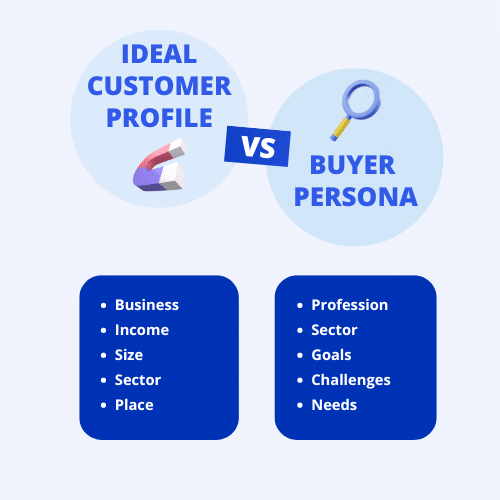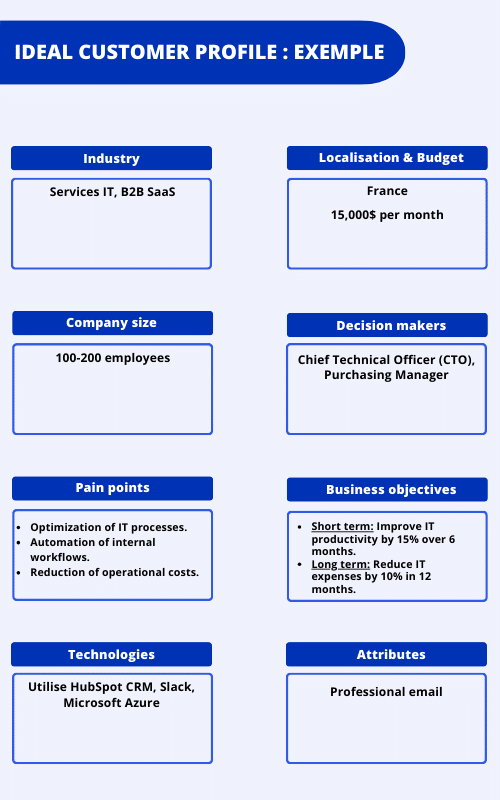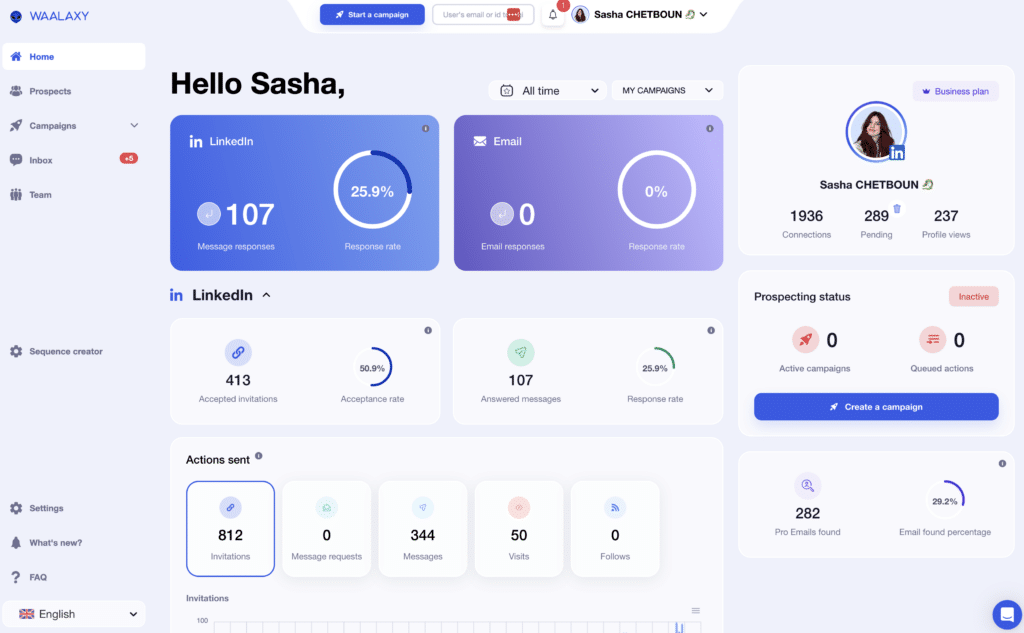The ICP sales is a strategic tool for optimizing your sales efforts on the most relevant customers. 👀
Here, we’ll explain how to establish an effective ICP, enabling you to better segment your market, prioritize your prospects and align your sales and marketing teams.
Without further ado, let’s get started! (Reading time: about 4 minutes 🔎)
What is an ICP in sales?
An ICP (Ideal Customer Profile) in sales is a detailed representation of the type of company that constitutes an ideal customer for your product or service.
Roughly speaking, it takes into account criteria such as:
- 🟣 Company size.
- 🔵 Sector.
- 🟣 Location.
- 🔵 Revenues.
- 🟣 Challenges.
- 🔵 Customer’s specific needs.
The aim is to target 🎯 accounts with the greatest conversion potential.
By clearly defining your sales KPI, you’ll be able to optimize your resources, tailor your prospecting approach and prioritize prospects with a high probability of purchase. 💸
A well-designed sales KPI helps improve conversion rates while reducing time wasted on irrelevant leads.
What’s the difference between ICP sales and ICP marketing?
The main difference between the two is the objective and the approach. 👀
Let me explain. ⬇️
ICP sales aims to identify the ideal companies to target, focusing on criteria such as:
- Company size.
- Sector.
- Revenue.
- Location.
➡️ Its aim? Qualify leads and prioritize the customers most likely to generate sales. 😇
ICP marekting, on the other hand, focuses on understanding customer motivations, behaviors and needs. Among other things, it analyzes:
- Interests.
- Purchasing behavior.
- Preferred communication channels.
➡️ Its aim? Tailor marketing messages to attract and engage prospects in the sales cycle. 🔄
If I had to make a quick summary: 👇🏼
- 1️⃣ ICP sales ⭢ prioritize accounts for sales teams.
- 2️⃣ ICP marketing ⭢ create more targeted campaigns to attract and interest these accounts.
What’s the difference between ideal customer profile and buyer persona?
Don’t understand the difference between the ideal customer profile and the buyer persona? We’ll explain. 👇🏼
1️⃣ The Sales KPI is an ideal representation of the company or account you wish to target. As previously mentioned, it takes into account:
- 📏 Company size.
- 📍 Business sector.
- 📈 Sales.
KPI is particularly used in B2B environments, and is used to find out which accounts are most likely to generate revenue.
2️⃣ The buyer persona, focuses on the individual. It’s a semi-fictional profile that represents the typical buyer or end-user. It takes into account:
- Behaviors.
- Motivations.
- Individual challenges.
It is often used in Btob and B2c to guide marketing messages and sales strategies.
However, they are often used together to have a more coherent and targeted sales and marketing approach. 🎯

Why create a sales ICP?
By targeting 🎯 the companies that most need your solutions, you’ll optimize your time and resources, and increase your chances of conversion.
What better way to express what I’m saying than with a chart? 👇🏼
| Reason | Benefits |
|---|---|
| Target the right prospects | Concentrate your efforts on the companies most likely to buy, thus increasing your chances of success. |
| Save time | Reduce sales cycles by avoiding unqualified prospects, and focus on high-potential accounts. |
| Align sales and marketing | Ensure that sales and marketing teams work together, targeting the same types of prospects. |
| Optimize resource allocation | Effectively invest effort and budget on the most profitable prospects, improving ROI. |
| Improve conversion rates | Increase the chances of closing sales by targeting companies that really need the solutions we offer. |
Find your Sales ICP in 6 steps
Now that you know what it is, you’ll need to focus your resources on high-potential prospects, improve your marketing campaigns and increase your conversion rates. 📈
And it starts with these 6 steps! ⬇️
1) Think about your product strategy
The first step is to think about your product strategy. You need to know what value your product or service brings to your customers. To do this, ask yourself the following questions: 👇🏼
- What are the main advantages of your offer?
- What specific problems does your product address?
- Who in the market most needs these solutions?
By doing this, you’ll better understand the industries, company sizes and types of customers who find the most value in your product.
You can also determine whether your offering is more suited to small, medium or large companies! 👀
In short, you’ll have understood, a good understanding of your product strategy guarantees that you’ll be targeting 🎯 the right prospects right from the start.
2) Choose a customer list
The second step is to choose a customer list that you feel represents your ideal target.
To do this, start by analyzing your existing customers 🔎 identifying those who derive the most value from your product or service, and who have the best satisfaction rates.
Why 🤔 Well, it helps you understand which type of business is most likely to match your offering. 👀
Quick tip, consider the company’s size, industry, budget and purchasing process.
That’s not all, then focus on customers who are loyal and regularly generate revenue.
Why? 🤔 By doing so, you’ll be able to refine the criteria that define your ideal customer! 😇
3) Collect the data
Right, now you need to gather data that’s both quantitative and qualitative! ✨
⭢ For quantitative data, focus on things like:
- Company size.
- Sales figures.
- Business sector.
- Number of employees.
- Technologies used.
This information can be obtained via your CRM, surveys or simply public databases (it’s a gift 🎁).
⭢ For qualitative data (just as important, as it helps you understand your customers’ behavior and motivations), focus on:
- What are their main challenges?
- How do they use your product?
- What features do they find most useful?
This data can be obtained through interviews with your customers or via feedback and case studies. 👀
If you combine these two types of data, you’ll be able to define your best customers.
4) Segment your market
So far, you’ve segmented your target groups. But are you familiar with psychographic segmentation?
It enables you to understand your customers’ deepest motivations, i.e. their values, beliefs and buying behaviors.
This helps you tailor your messages to directly address what motivates their decisions.
A company looking to innovate will respond differently to your offer than a company prioritizing stability.
Then there’s behavioral segmentation, which allows you to target customers based on how they interact with your product. 👀
For example, some customers buy regularly, others only during promotions. And understanding this difference will enable you to refine your communication strategy and then, propose relevant offers to each of your segments! 😇
5) Collaborate between teams
Now, I’m not telling you anything new, but the more you work hand in hand (isn’t that romantic?), the more efficient you’ll be. 👋🏽
Indeed, marketing is often the first to attract and qualify leads, while sales teams are the ones who close the deals. 🫱🏽🫲🏼 That’s where collaboration comes in!
Collaboration enables key information to be shared 🗝️ on customer information, behaviors and needs.
Ok, let’s take an example, marketing can provide data on :
- 🔵 Engagement trends.
- 🔵 Communication channels.
- 🔵 Campaign performance.
In return, sales teams can share information on:
- 🟣 Common objections.
- 🟣 Buying cycles.
- 🟣 Decision-making processes in target companies.
6) Create a detailed profile
For this final step, we’re going to bring together all the information we’ve collected previously to get a clear and precise view of the ideal customer. 🗾
Already, your profile should include firmographic data (sector, business size, sales), and psychographic data (needs, motivations, challenges).
<But that’s not all, add information on the buying process (decision-makers, preferred communication channels) as well as the technologies used by your prospects. 🔎
If you haven’t quite got the hang of it, here’s a quick example. ⬇️

How to contact your sales ICP?
Well, it’s all very well knowing how to define your sales KPI, but now it’s time to act! And when I say act, I’m referring to contact him. 💬
And for that, we advise you to use a tool that will make your life easier, and save you time. Let me introduce you to Waalaxy! 👽
This is a tool for automating and optimizing your prospecting campaigns on LinkedIn and by e-mail. With it, you’ll be able to create customized message sequences (from over 99 templates), without losing quality. ✨
In a nutshell, Waalaxy is:
- CRM integration.
- Performance tracking.
- Automatic prospecting scenarios.
- Automate LinkedIn messages and emails.
- Import leads from LinkedIn Sales Navigator.
- Multi-channel sequences for a complete approach.
- Follow-up and automatic follow-up (based on prospect responses).
- Message personalization with variables and an AI assistant.
- Advanced lead segmentation according to precise criteria (sector, position).
With all its tracking and intelligence features, you’ll be able to easily adapt your messages according to the responses you receive, and thus maximize your conversion rates.
With, you’ll be able to speed up your sales cycle and save precious time.

Ready to contact your ideal customer profile? Click here! 👇🏼
How about a quick recap?
If there’s one thing you need to remember, it’s that creating a sales KPI is much more than a simple segmentation exercise. It’s a strategic lever for directing your sales efforts towards those customers who will bring the most value to your company.
It improves campaign efficiency and maximizes the use of resources.
But that’s not all, it accelerates conversion and strengthens customer loyalty by offering solutions tailored to their needs – what more could you ask for? 👀
Frequently asked questions
Hang on, we’ve still got a few more questions to answer that I think might be of interest to you. 👇🏼
What should a customer profile contain?
A customer profile needs to contain certain detailed information in order to better understand your customers’ needs and behaviors. It’s a bit like when you’re at a restaurant, you like to know what’s in your dish before you choose it, right? 🤔
Well, here it’s the same thing! So, here are the main things to add: ⬇️
- 🔵 Demographic data ⭢ age, gender, location, education level, occupation.
- 🟣 Firmographic data (b2b) ⭢ company size, business sector, sales, location.
- 🔵 Needs and pain points ⭢ identify the challenges the customer faces.
- 🟣 Purchasing behavior ⭢ purchase frequency, channels used, decision factors.
- 🔵 Motivations and objectives ⭢ what motivates the customer to make purchasing decisions, whether price, quality, or reputation.
- 🟣 Customer Lifetime Value (CLV) ⭢ anticipating the value a customer will bring to your company over the long term.
- 🔵 Communication channels ⭢ by which means the customer prefers to be contacted (emails, social networks).
How to make a good KPI?
If you want to make a good ideal customer profile, then here are some key steps 🗝️ :
- 1️⃣ Analysis of existing customers.
- 2️⃣ Data collection.
- 3️⃣ Prospect segmentation.
- 4️⃣ Team alignment.
- 5️⃣ Validation and adjustment.
Now you know all about the ICP sales! ❄️









